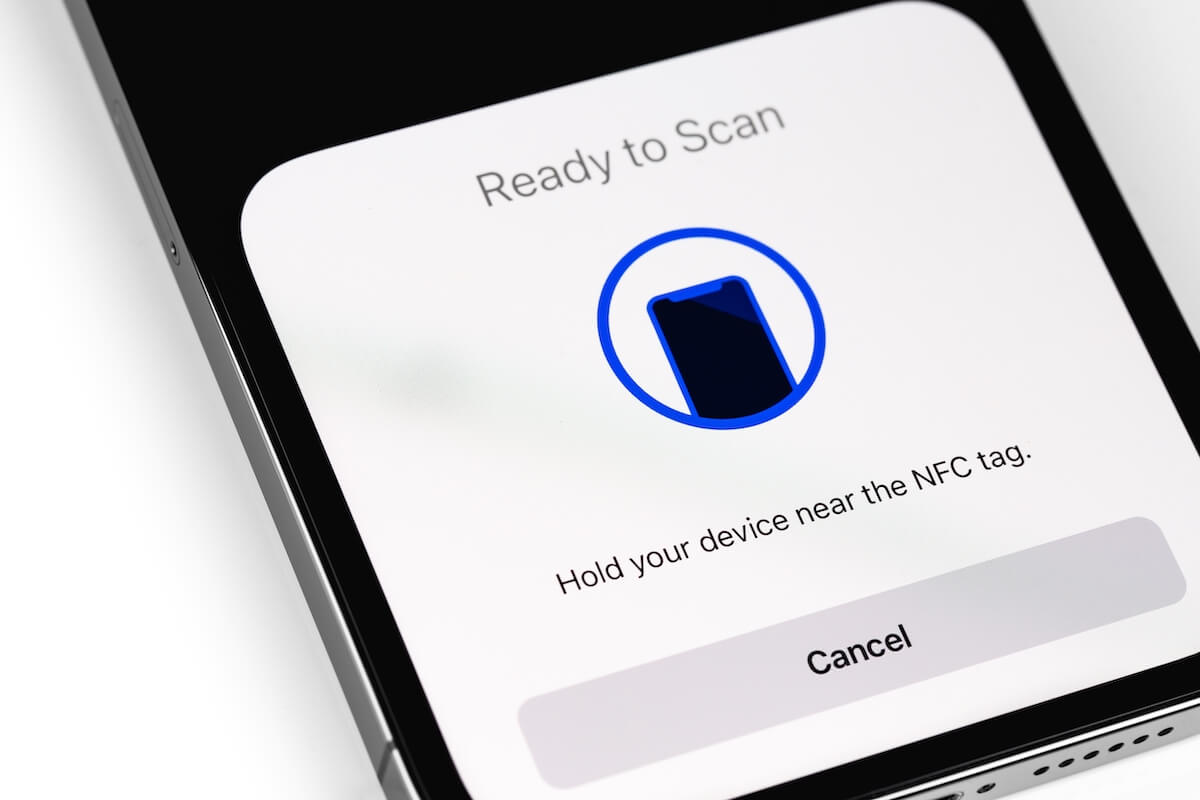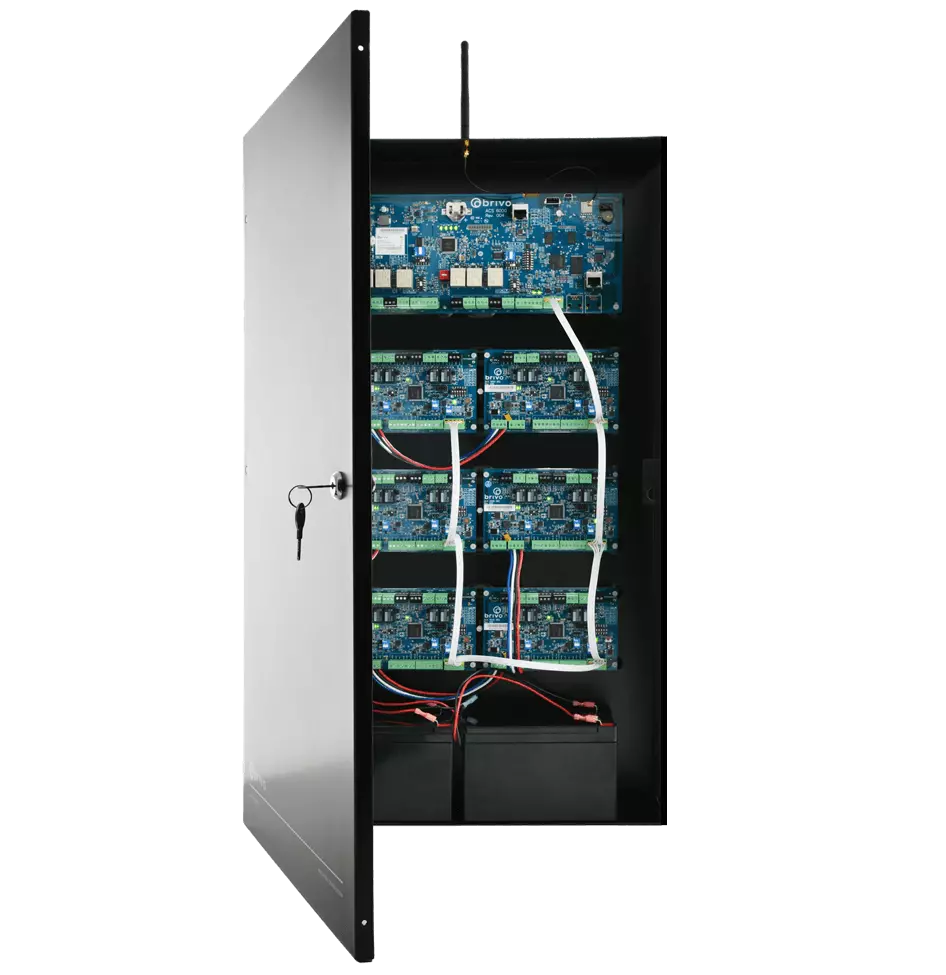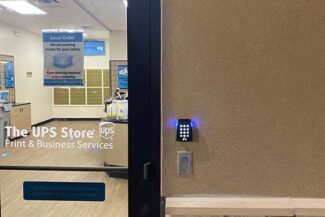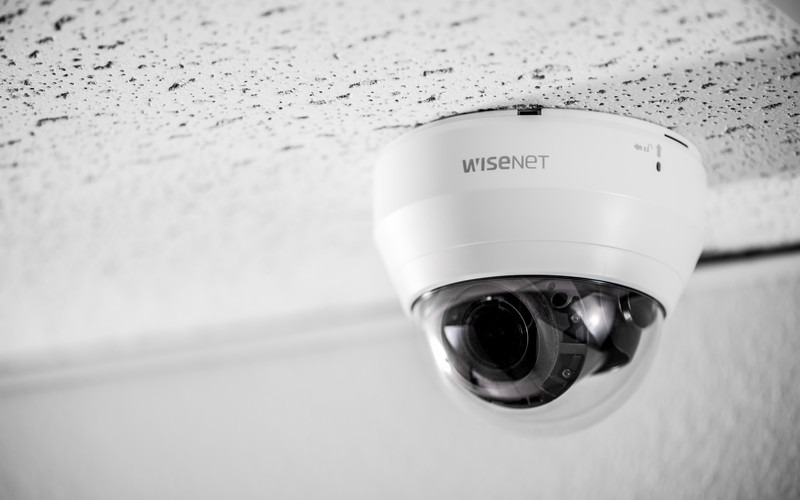Door Intercom systems provide two-way communication between several spaces. They can be used for a range of things, from simple interconnectivity in homes and businesses to acting as a professional access control system for security.
This in-depth tutorial will cover the numerous intercom system parts, the many intercom uses, and how to pick the best intercom security system.

What are door intercom systems?
A device that enables communication between one or more persons in various locations is called an intercom system. An audio-only device that can be used for basic talks, such as notifying guests at the front door, is the most fundamental kind of intercom system. Users can see and hear each other thanks to the video and audio capabilities of more sophisticated systems. In homes, companies, and educational institutions, intercom systems are frequently used.
Modern intercom systems are crucial for security. They are crucial for enterprises with critical security procedures that cannot tolerate disruptions since they can be utilized as a backup way of communication when phone networks are down due to a natural disaster or technical fault.
Access control features are also included in intercom systems, enabling authorized workers to remotely open doors rather than having to physically open them whenever a visitor arrives. Because of this, commercial and office intercom systems are essential for companies that need to deter burglars and give employees secure access day or night.
Security guards can watch activities outside their facilities from anywhere in the globe by integrating intercom security systems with surveillance cameras. Organizations can increase their security by combining security intercoms with commercial surveillance cameras.
Access Your Office with Smartphone
Discover why thousands of companies have Access Control System

How does a door entry intercom system work?
A variety of components make up an intercom door entry system, which is used to manage access at one or more entry points:
The equipment used to communicate with visitors is the master station, which is situated at the entrance. It may seem as a video phone, an audio speaker with a microphone, or even a straightforward keypad. It can make a wired or wireless link to a substation. To provide entry to the facility when it is approved, the master station may also have a release mechanism, such as an electronic door opener.
Substation: The gadget found in individual rooms or flats is known as a substation. This can be a smartphone, computer monitor, surveillance camera, or other device that lets residents talk to and let in visitors. It allows residents to hear and reply to visitors by connecting directly to the master station for communication.
Buzzer: Door entrance intercom systems frequently contain a buzzer. Visitors can notify the residents of their workplace or apartment that someone is at the door by pressing the buzzer at the master station, which also turns on the microphone and speakers. This enables residents to speak with visitors before allowing admission.
Video camera: Some entry intercoms have a built-in camera that records and sends a picture of the visitor to the substation, allowing the building’s inhabitants to analyze a guest more effectively and confirm the visitor’s identification before allowing access. This capability is very helpful for apartment intercom systems used in multifamily housing.
Electronic door openers and other access control features are included in certain intercom door entry systems. The door opener unlocks the door, letting visitors to enter, when an occupant gives access through the substation. Access to particular places and times of day can also be restricted using intercom systems with door releases.
Smartphone applications: Due to the widespread use of smartphones, mobile apps have been developed that let residents control their intercom entrance systems from their phones. The convenience of door entry intercom systems is significantly increased by mobile access control, which enables managers to authorize access to guests from any location.
Connectivity: Intercom access control systems are normally linked to the substation via a wired or wireless connection. Because it does not require running cables through walls and ceilings, a wireless connection is preferred for the majority of applications. Wireless doorbell intercom system connections are also more secure because they cannot be physically tampered with.
Power unit: In order to supply electricity to the master station and substation, door entry intercom systems typically need a power unit. Depending on the model, this could be an internal DC power supply or an external AC power adapter. However, some wireless devices come with an integrated battery that does not require an external power source. Although the battery life of these devices varies based on the type and level of usage, they can generally go months without a charge.
Software: Directory software can be utilized to speed up access for approved visitors in more sophisticated entry intercom systems. For instance, when a visitor buzzes the master station, the directory software can send calls to the appropriate individual or division and offer an audit trail that shows who was authorized access when. When controlling access to a facility, this enables more control and accountability.
Cloud Based Access Control
Learn about cloud based access control system and its futures.

Components of a commercial keyless entry system
To guarantee proper operation, business keyless entry systems often include electronic or magnetic commercial strikes, or office keyless door locks, a proximity reader or sensor, and credentials for each user to authenticate their identification.
Door locks for keyless systems
Keyless locks are generally electrical or magnet-based and may be controlled remotely. To operate the locking mechanism on electronic door entry systems, a power supply is required. Depending on the kind of keyless door system, providing an approved credential will either cause the door to receive power and unlock, or it will temporarily disconnect the power source to enable entrance. They are built with reinforced deadbolts and other security features to be as safe and tamper-proof as possible.
Proximity reader or sensor
Before providing entry, a proximity badge reader system checks each user’s identification. It usually includes an antenna, a processing board, an LED display, a keypad, and other components. It is installed near the entrance and reads each user’s credentials and interacts with the access control system to determine whether or not they are permitted to enter.
Credentials
The type of credential used in a business keyless entry system will be determined by the device itself. Some of the most typical credentials used with keyless door entry systems are key cards and fobs. As authentication mechanisms, PIN access codes, passwords, biometrics, and mobile applications can all be employed.
The biggest advantage of keyless door entry security systems for businesses is that access codes may be altered quickly if necessary. Biometric access control credentials that are more sophisticated, such as fingerprints or retinas, are unique to each user and provide a higher level of protection.
Join UPS Stores Using Access Control
With Cloud Based Access Control, UPS Stores can regulate and track who enters its facility for PO Boxes.

Types of door intercom systems by function
Based on its function, kind of technology, and connectivity possibilities, intercom door systems can be divided into many categories. There are three main types of intercom door entry systems based on their functionality:
Intercoms are utilized in this type of system to facilitate internal communication within flats or rooms within a building. This can be useful in instances where residents need to swiftly interact with one another without leaving their rooms. More recent communication methods, such cell phones, have essentially superseded this form of intercom.
External communication: In this system, the intercom is utilized to communicate between the substation and an outside visitor. This enables residents to interact with guests. However, because there is no door release intercom system, inhabitants still have to physically open the door to let people in. When a door release mechanism is not required, such as in modest residential applications like single-family homes, this sort of intercom is frequently employed.
Intercom door release system: This system has an electronic door opener that enables visitors to enter the substation. Due of its increased convenience, it is most frequently employed in big residential, commercial, and industrial applications. The intercom buzzer and door release button are often found at a building’s entrance. When pressed, it transmits a signal to the substation. After speaking with the visitor, the person in charge can press a button to provide entry to guests.
Commercial security cameras for business
- Business security cameras with enhanced coverage and IR that improve situational awareness
- Video analytics with AI to find incidents
- Hours of video are easily sorted through by Video Search to locate a suspicious person or vehicle.
- Integrates with third-party ONVIF® compliant platforms

Types of entry intercom systems by technology
Depending on the technology utilized, intercom door entry systems can also be classed. The most typical varieties are:
audio intercom system
A master station and one or more substations make up an audio door intercom system, which is typically utilized in residential applications. The audio door entrance intercom system enables communication between the master station and substation via a microphone and speaker.
video intercom system
Video door intercom systems with a video component let users see visitors at the door using a tiny built-in camera before allowing them access. They are far more secure than voice intercoms since residents may physically confirm a visitor’s identification before providing entrance.
telephone intercom systems
A telephone intercom, which connects the master station and substation using a landline or cell phone, is another sort of door entry intercom system. Visitors select the phone number of the person they wish to speak with on the keypad, and their call is then routed through the intercom. They type a code or hit a designated button on an app if the resident wants to permit them access.
Don’t risk legal
responsibilities.
Contact us right now to set up a consultation with one of our qualified security consultants. We will assist you in seamlessly navigating the complicated terrain of video surveillance laws. Your company deserves the greatest protection possible!
Types of intercom entry systems by connectivity options
The connectivity choices, or how the master station connects to the substations, are another way to classify intercom systems. Intercom systems include:
System for wired intercom
Wired intercoms use a hardwired link between the master station and substations via cable that must be installed in walls or ceilings. In order to power the system’s components, this hardwired intercom system also needs cabling.
Because to the intricacy of wiring the system, larger facilities with several substations must be erected by professionals. Due to the necessity for frequent repairs and troubleshooting, installation costs and time can be significant. Because extra wires must be installed, expanding the system might be difficult.
Certain systems may need to be totally altered if they are to be used for more complex applications. For instance, a 3wire intercom system is typically advised for structures with fewer than 30 units, whereas a 4wire system can be utilized for structures with up to 100 units. If you have a 3-wire intercom system and want to add more than 30 substations, you might have to replace the entire setup.
Despite its drawbacks, a 2-way wired intercom system is a very safe and dependable choice because it is immune to signal loss and interference.
Wireless intercom system
Due of their ease and low maintenance requirements, wireless intercoms are gaining popularity. Instead of using cables, they employ Wi-Fi or Bluetooth technologies to link the master station and substations.
Since wireless components are simpler to install than cable systems, the installation process is typically simple. As a result, installation expenses, setup time, and maintenance expenses are all reduced.
Walls, electrical equipment, and other wireless systems can, however, reduce the signal strength, resulting in signal loss or interference. For this reason, it is essential to guarantee high signal quality before installing this kind of equipment. Installing extra antennae or repeaters may be required to provide a robust and dependable connection if the signal is weak in some regions of the building.
Another problem with wireless door entry intercom systems is bandwidth. A two-way wireless intercom system requires a specific amount of bandwidth to send audio, video, and other data between the master station and substations. Thus, it is crucial to make sure that the system selected can manage the facility’s data transmission requirements.
Although a wireless door entry system is typically more convenient and cost-effective than a wired system, it is nevertheless subject to security issues like hacking. To combat this risk, the system must be well-protected with access control and encryption.
Notwithstanding these worries, a front door wireless intercom system provides a number of advantages, including:
These wireless front door intercom systems are affordable for any application because smartphones may be used to replace substations.
Installation and upkeep take less time and money.
the ability to change the system’s location or size as necessary.
The device may be placed throughout a building without worrying about cable problems.
Very practical because users may use the Internet to access these remote intercom systems from anywhere.
Networked intercom system
Due to their flexibility, networked intercoms, a relatively new type of system, are growing in popularity. The master station and substations are connected by an IP network connection, allowing them to be placed anywhere without affecting the audio or video quality. Operators may control the system from anywhere thanks to users’ remote access capabilities.
This kind of system may easily be enlarged or relocated by adding or removing components from the network, and the installation procedure is also rather straightforward. The biggest drawback is that a strong and secure connection requires a steady Internet connection to be available at all times.
An Internet door entry intercom system can store data locally or in the cloud, adding an extra layer of protection. Live broadcasting, access management, and automated responses are just a few of the capabilities offered by cloud-based door intercom systems.
A web-based door intercom system can also be integrated with other technologies, such access control and video surveillance, to provide a more complete security solution.
Hardwired intercom system
Residential applications benefit from the inexpensive cost of mains hardwired door entry intercom systems. Instead of radio waves or Wi-Fi, this type of system communicates through the power grid. It can be installed fast and easily and doesn’t need any additional wiring or connections.
Phone or smartphone intercom system
A phone line or a mobile phone network must be connected to an intercom phone system for it to function. The phone, which can be wired or wireless, serves as the intercom system’s communication tool.
Large residential buildings are where they are most frequently used because they are so practical, especially smartphone-based systems. More business and enterprise applications are being developed as a result of the convenience and rising smartphone usage.
What is the best intercom system?
The ideal entry door intercom system is determined by the specific application and available funds. While choosing an intercom system, there are various things to take into account, including:
1. Location
To assess the intercom system’s viability and suitability for the particular setting, it is critical to know the precise place where it will be installed.
A mains-hardwired intercom system, for instance, would be the most affordable and straightforward option if the intercom is to be placed in a residential structure. On the other hand, an Internet-based system might offer a building greater capabilities and flexibility.
Whether it will be an indoor or outdoor intercom system is another factor to consider. While interior systems are significantly easier to install and maintain, outdoor entry intercoms need more substantial weatherproofing.
Both kinds of systems need a power supply, so it’s crucial to make sure there’s a working outlet or connection to the mains. While choosing an Internet intercom system, location is particularly important because access to a dependable Internet connection is required.
Range 2.
The range is a crucial feature to take into account when choosing an intercom system since it will define which sort of intercom system is best for a given structure. The amount of the region the intercom can cover will depend on its range, and various systems offer varying ranges.
For instance, hardwired intercom systems are normally ideal for small to medium-sized residential buildings, whereas Internet-based intercoms can cover bigger areas. But, if the system needs to cover a broad region or several buildings, a wireless intercom might be the ideal alternative.
Because they don’t need additional cabling or wiring, wireless systems are more flexible than wired systems. They also give the flexibility to be deployed in various locations and can deliver two-way communication over greater distances.
Yet, a wired system can be more cost-effective if the intercom will only be utilized in a limited space. In locations with intermittent Internet access or limited access to electricity, wired intercom systems are often less expensive than their wireless counterparts.
Third, safety
While choosing an intercom system, security is another important element to take into account. This will decide the degree of access restriction required for the specific application.
In some home situations, a sophisticated intercom system with strict access control may not be required. In commercial settings or regions with restricted access, however, a reliable intercom system with numerous security measures would probably be needed. In these situations, the intercom system can be connected with other access control methods, including smart card readers or biometric readers. This makes sure that only authorized individuals are permitted entrance to the building.
4. Installation ease
The installation of an intercom system can be costly and time-consuming. The total installation costs might be decreased by choosing an intercom system that is simple to set up.
This will depend on the size and complexity of the wireless intercom system. A plug-and-play system can shorten installation time. Several vendors offer systems that are pre-programmed and ready to use after installation. This eliminates the need to set up the intercom system and can save installation expenses.
An expert electrician or technician may be needed to install a wired intercom system because it is frequently more difficult than a wireless one. Physical cables must be run from each intercom station to the central hub in wired systems. Cables might be twisted pair, coaxial, or fiber optic depending on the system. Wire installation can be time-consuming and costly.
For Internet-based intercom systems, another factor to take into account is the Internet connection. Even if the remainder of the system is wireless, many experts advise choosing a wired connection to the Internet to guarantee a more dependable connection.
5. The quantity of substations and users
Knowing how many substations and daily users the system will have is crucial when choosing an intercom system. This will have an impact on the type, size, and price of the intercom system selected. For instance, a two-way intercom system can be appropriate for small home applications with just one or two users. For larger uses, such workplaces, more sophisticated systems with many substations will be needed.
The kind and size of the central hub will depend on the number of users. This must accommodate the extra users and supply enough power for all substations.
6. Sturdiness and adaptability
While choosing an intercom system, durability is another crucial issue to take into account. The system ought to be able to survive regular use without degrading. This includes being able to resist changes in temperature and humidity as well as power outages. To ensure that the equipment can withstand the rigors of daily use for many years, it should also be built from sturdy, high-quality materials.
While selecting an intercom system, flexibility should also be taken into account. If the system will be put in a large building with a large number of users, it is crucial to choose an intercom system that allows for future growth. The greatest solution might be a wireless intercom system because it enables simple expansion without requiring system rewiring. Some manufacturers also provide modular systems that may be easily expanded as required.
7. Video features
In addition to audio signals, certain intercom systems may send and receive visual signals. Video features can increase security by enabling users to visually recognize visitors before authorizing access. Some systems have night vision and motion sensing.
Video intercom systems might, however, be more expensive and take longer to setup. Prior to making a purchase, the advantages of these qualities should be compared to the price.
8. Integration capabilities
Other technologies, such access control and video surveillance, can be combined with intercom systems. Users can easily keep an eye on who is entering and exiting a building, which helps improve security.
Certain intercom systems have the ability to be coupled with automation systems, allowing for automated reactions to particular circumstances. For instance, the intercom can be set up to open a door whenever a permitted person enters the space.
Smartphone integration with modern intercom systems enables users to access video feeds and control the system from a distance. As users can keep an eye on their homes or places of business from anywhere in the world, this can increase convenience and security.
The majority of smartphone apps let users adjust the settings to meet their own demands. This may entail generating user profiles for each substation and establishing timetables for when the system is active. Because less hardware is needed, it might also result in cost savings during purchase and installation. But, it’s crucial to check if the system works with a variety of cellphones and operating systems.
It is crucial to think about which aspects are most crucial because integration capabilities vary from system to system. Users must check that the system works with their current hardware and software.
9. Simple access techniques
Depending on the application, an intercom system that provides numerous entry points to the property may be advantageous. A mix of keypads, cards, and other entry mechanisms can increase security and convenience.
Because they are more convenient than conventional access techniques, touchless and keyless door entry access is growing in popularity. They also offer better security because they reduce the possibility of unwanted access.
Touchless access refers to any type of access that does not require the authorized user to touch the gate or entrance. A sensor that turns on when the authorized person approaches and an automated door opener are typically used.
Operators can grant visitors access using a mechanism called “contactless access” without having to be physically present. Someone could use an app to open the security gates or doors when they are in another nation.
Users should be able to simply provide access to visitors or contractors using the features of an intercom system. Temporary codes provided through text message and remote access from a smartphone can both be used for this.
10. Management platforms based in the cloud
The usage of cloud-based services is the most recent development in intercom systems. This enables users to save audio, video, and other data on a remote server, allowing access from anywhere with an Internet connection.
Because customers can access the system from many locations, cloud-based services offer increased security and convenience. Some systems provide capabilities like remote troubleshooting and automated updates.
Prior to choosing a system, it is crucial to make sure the cloud-based service is secure and dependable. Users of some services may need to pay monthly fees or buy more storage space.
If the intercom system can control several access points, it is another thing to take into account. In larger structures where access from parking garages or other facilities is necessary, this can be advantageous.
In these situations, it is critical to make sure the system can support several concurrent users and offer access to the appropriate substations. Some systems allow users to modify their access points so that they can only access particular parts of the structure or property.
As users may simply set up access to specific portions of the building or property, these capabilities can offer increased convenience and security.
Buyer’s guide: The best entry intercom systems for your property
While choosing an intercom system, the total cost of ownership should also be taken into account. This includes both the initial expenditures of hardware and installation as well as continuing expenses for upkeep, upgrades, and replacements. Costs associated with integrating the system with other technologies must also be taken into account. Certain intercom systems may also charge users monthly fees for cloud-based services or extra functionality.
A reliable provider is essential because an intercom system is an expensive investment that is supposed to secure a property. Before making a purchase, it is important to do some research on the supplier and their goods. Reading real customer reviews might also aid in spotting any potential issues. Verify that the company provides dependable customer service as well as frequent updates and maintenance. In the event of any faults or defects, the company should offer a guarantee.
For residential or commercial properties, intercom systems are a practical solution to provide access control and security. Users can choose the finest solution to match their needs by taking into account aspects like range, wireless or wired installation, cloud-based services, integration possibilities, and total ownership cost.
A crucial choice is selecting the best intercom door entry system. To determine which intercom security system is best for your needs, evaluate the leading intercom manufacturers and intercom products currently available on the market.
Have questions? We can help
Our security experts can help you implement the right security system for your business.






